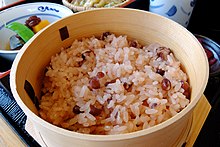Red bean rice
 | |
| Region or state | East Asia |
|---|---|
| Associated national cuisine | Chinese Japanese Korean Taiwanese |
| Main ingredients | Rice, adzuki beans |
| Similar dishes | Kongbap |
Red bean rice, called patbap (팥밥) in Korean, sekihan (赤飯) in Japanese and hóngdòu fàn (红豆饭) in Chinese, is an East Asian rice dish consisting of rice cooked with red beans.
Regional varieties[]
Japan[]

Sekihan (赤飯, lit. 'red rice', rice boiled together with red beans[1]) is a Japanese traditional dish. It is sticky rice steamed with adzuki beans, which give a reddish color to the rice, hence its name.[2]
The rice of ancient times of Japan was red. Therefore, red rice was used in the ancient . Red rice has a strong taste of tannin, and its cultivation has been almost completely abandoned[citation needed]. The present sekihan is colored red using adzuki.
Sekihan is often served on special occasions throughout the year in Japan, for example, birthdays, weddings and some holidays, such as Shichi-Go-San.[2] In some places it is customarily made when a young woman reaches menarche, although this is less common now than it was in the past.[3]
Sekihan is so strongly connected with celebrations that the phrase "Let's have sekihan" has acquired the meaning "Let's celebrate."[citation needed] It is believed that sekihan is used for celebrations because of its red color, symbolic of happiness in Japan.
It is usually eaten immediately after cooking but it may also be eaten at room temperature, as in a celebratory bento (boxed lunch). Sekihan is traditionally eaten with gomashio (a mixture of lightly toasted sesame and salt).
There are also regional varieties of sekihan. Some versions call for sugar instead of salt to give a sweet flavor. Others use amanattō (sweetened bean confectionery) instead of adzuki. Many people also use sasage(ササゲ, black cowpea beans) instead of adzuki bean.[4]
Korea[]

Patbap (팥밥, [pʰat̚.p͈ap̚], lit. 'red bean rice') is a bap (cooked grain dish) made with non-glutinous white short-grain rice and adzuki beans.[5] It is a traditional Korean dish, usually eaten in the winter months, but it is also prepared for holidays and birthdays.[6] For that reason it is sometimes referred to as "birthday rice."[7]
Patbap is typically made in the same way as making huinbap (cooked white rice), with the additional step of mixing cooked whole adzuki beans with soaked white rice before boiling.[5] Fresh, undried beans can be used without boiling in advance.[8] Four parts rice and one part adzuki beans may be used, but the amount of adzuki beans can be adjusted to taste.[6][8] In some regions, uncooked red or black adzuki beans are husked and ground before being mixed with soaked rice.[5] In Korean royal court cuisine, rice was cooked in the water where adzuki beans were boiled.[5]
- Patbap (팥밥) – Adzuki beans are boiled with 6‒7 parts water until cooked but intact.[8] They are then mixed with soaked rice, and boiled again in water.[8] Usually, plain water mixed with the water in which the beans were boiled is used.[8]
- Budungpat-bap (부둥팥밥) – Budung-pat means fresh (rather than dried) beans.[8] Ripe fresh adzuki beans are mixed with soaked rice and boiled.[8] Less water is used than with dried beans as the fresh beans contain moisture.[8]
- Geopipat-bap (거피팥밥) – Geopi-pat means husked beans.[8] Red or black adzuki beans are husked, ground using a millstone, and mixed with soaked rice.[8] Husked adzuki beans are an ivory white color.
- Jungdung-bap (중둥밥) – Whole adzuki beans are boiled in water and sieved, so that the water can be used to make reddish rice.[9] The sieved red beans can be sweetened and used in desserts.[9] If barley is also mixed in, the dish is called pat-bori-bap (팥보리밥; "adzuki bean and barley rice").[10] In Gangwon Province, a dish made with corn kernels (in place of rice) and adzuki beans is called oksusu-pat-bap (옥수수팥밥; "corn and adzuki bean rice").[11]
Patbap is a traditional recipe in the Pyongan Province, where adzuki beans are grown in abundance.[5]
See also[]
- Kongbap – similar Korean dish made with soybeans
- Patjuk – red bean porridge
- Red bean cake – similar Japanese rice cake made with red beans
- Red beans and rice
External links[]
- Rice with azuki beans (osekihan) recipe. https://japan.recipetineats.com/rice-with-azuki-beans-osekihan/
References[]
- ^ Kenkyusha's New Japanese-English Dictionary, ISBN 4-7674-2015-6
- ^ Jump up to: a b Tsuji, Shizuo; Fisher, M.F.K. (2007). Japanese Cooking: A Simple Art (25 ed.). Kodansha International. pp. 280–81. ISBN 978-4-7700-3049-8.
- ^ Lebra, Takie Sugiyama (1985). Japanese Women: Constraint and Fulfillment. University of Hawaii Press. p. 72. ISBN 978-0-82481025-2. Retrieved 18 October 2018.
- ^ "Bring Yourself Good Luck With Sekihan, a Traditional and Auspicious Japanese Dish!". Japan Info. Retrieved 2019-09-03.
- ^ Jump up to: a b c d e 강, 인희. "Patbap" 팥밥. Encyclopedia of Korean Culture (in Korean). Academy of Korean Studies. Retrieved 24 July 2017.
- ^ Jump up to: a b "P'atpap" 팥밥. Chosŏn ryori (in Korean). . Retrieved 24 July 2017.
- ^ "팥밥 만드는 법, 생일밥하면 팥찰밥!". 씽씽 라이프 (in Korean). 2013-03-02. Retrieved 2017-08-17.
- ^ Jump up to: a b c d e f g h i j "Patbap" 팥밥. Doopedia (in Korean). Doosan Corporation. Retrieved 24 July 2017.
- ^ Jump up to: a b 강, 인희. "Jungdung-bap" 중둥밥. Encyclopedia of Korean Culture (in Korean). Academy of Korean Studies. Retrieved 24 July 2017.
- ^ "Pat-bori-bap" 팥보리밥. Doopedia (in Korean). Doosan Corporation. Retrieved 24 July 2017.
- ^ "Oksusu-pat-bap" 옥수수팥밥. Doopedia (in Korean). Doosan Corporation. Retrieved 24 July 2017.
- Bap
- Chinese rice dishes
- East Asian cuisine
- Holiday foods
- Japanese rice dishes
- Korean rice dishes
- Legume dishes